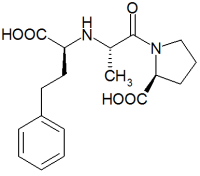(barrier2)
Two-barrier Model. If a tracer is transformed within the cells, or if its distribution is heterogeneous, two intracellular regions have to be considered, with a second barrier between them.
Lactate
Lactate is a natural substrate of the liver. It is taken up by hepatocytes and is transformed to pyruvate by the action of the enzyme lactate dehydrogenase. The hydrogen atom bound to the central carbon atom of the molecule is transferred to NAD that is thus transformed to NADH. Various other dehydrogenases transfer this hydrogen to other metabolic intermediates who form a separate intracellular pool that can be assessed by the multiple indicator dilution method.
Experimental design
The following tracers were injected into the portal vein of an isolated buffer-perfused rat liver:
- [U14C]Sucrose
- [U14C]Urea (a tracer that is distrubuted rapidly within the perenchymal cells)
- L-[2-3H]lactate (CH3—C3HOH—COO–)
Samples from the vena cava were analyzed for beta radioactivity, and the two isotopes where distinguished by scintillation spectrometry. The label contained in urea was separated from that in sucrose by hydrolyzing urea using the enzyme urease; the resulting [U14C]CO2 was moved into the gas phase by acidification and trapped in phenyl ethyl amine.
Enalaprilat

Enalaprilat, (S)-1-[N-[1-(carbonyl)-3-phenylpropyl-L-alanyl]-L-proline, is a drug metabolite formed by hydrolysis of the antihypertensive drug [[http://www.rxlist.com/cgi/generic/enalap.htm| enalapril]]. It is taken up by hepatocytes, where, because of its low water solubility, it is bound to intracellular proteins. This results an additional intracellular pool of protein-bound enalaprilat. Enalaprilat is excreted predominatly into the bile.
Experimental design
The following tracers were injected into the portal vein of a perfused rat liver:
- [U14C]Sucrose
- [2-3H]Enalaprilat
Samples from the vena cava were analyzed for beta radioactivty. The two isotopes were distinguished by liquid scintillation spectrometry.
Calculations
Download JSim model MML code (text):
Parameter sets
There are two parameter sets in this applet:
- Lactate
- Enalaprilat
To change the parameter set:
- Select Load project parameter set from the ParSet pulldown menu.
- Choose the desired parameter set. This will automatically change the paremters as well as the data for the reference curve.
- Click on "Run" to use the new parameter set.
- Select the appropriate plot page.
If you want to optimize the parameters of the newly selected experiments:
- Click on the Optimizer tab (at the bottom of the left pane)
- Change all the DataSet entries under the "Data to Match" heading.
- Click on the Dataset entries to get a selection of data sets to choose from.
- Click on the Curve entries to get a selection of data columns to choose from.
- Hit the "Run" button.
We welcome comments and feedback for this model. Please use the button below to send comments:
Schwab AJ (1984), Extension of the theory of the multiple indicator dilution technique to variable systems with an arbitrary number of rate constants. Math. Biosci. 71:57–79.
Schwab AJ, Barker F 3rd, Goresky CA, Pang KS (1990) Transfer of enalaprilat across rat liver cell membranes is barrier limited. Am J Physiol 258:G461-75.
Author: Andreas J. Schwab (andreas.schwab@mcgill.ca)
Please cite https://www.imagwiki.nibib.nih.gov/physiome in any publication for which this software is used and send one reprint to the address given below:
The National Simulation Resource, Director J. B. Bassingthwaighte, Department of Bioengineering, University of Washington, Seattle WA 98195-5061.
Model development and archiving support at https://www.imagwiki.nibib.nih.gov/physiome provided by the following grants: NIH U01HL122199 Analyzing the Cardiac Power Grid, 09/15/2015 - 05/31/2020, NIH/NIBIB BE08407 Software Integration, JSim and SBW 6/1/09-5/31/13; NIH/NHLBI T15 HL88516-01 Modeling for Heart, Lung and Blood: From Cell to Organ, 4/1/07-3/31/11; NSF BES-0506477 Adaptive Multi-Scale Model Simulation, 8/15/05-7/31/08; NIH/NHLBI R01 HL073598 Core 3: 3D Imaging and Computer Modeling of the Respiratory Tract, 9/1/04-8/31/09; as well as prior support from NIH/NCRR P41 RR01243 Simulation Resource in Circulatory Mass Transport and Exchange, 12/1/1980-11/30/01 and NIH/NIBIB R01 EB001973 JSim: A Simulation Analysis Platform, 3/1/02-2/28/07.

